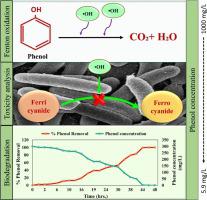Journal of Water Process Engineering ( IF 6.3 ) Pub Date : 2020-07-02 , DOI: 10.1016/j.jwpe.2020.101475 Megha Tyagi , Nisha Kumari , Sheeja Jagadevan

|
In this study, the efficacy of a hybrid treatment approach by integrating Fenton’s oxidation with biological treatment for removal of phenol from synthetic coke oven wastewater was investigated. Central composite design using response surface methodology was applied to optimize the dose of FeSO4 and H2O2 with maximum phenol removal and minimum toxicity. Results indicate that 6.3 mM and 20 mM of FeSO4 and H2O2 respectively, were capable of 74 % degradation of 1000 mg/L phenol, 99.99 % of 100 mg/L of cyanide with 10 % residual toxicity, which was acceptable for the next biological treatment step. On the basis of biodegradation studies it was found that a mixed consortium of three isolated bacterial strains namely BSPS_CN, BSPS_PHE and BSPS_PHE2 were capable of 98.8 % degradation of 300 mg/L phenol, which was remaining after the Fenton treatment. BSPS_PHE2 was found to be the most efficient with 92.45 % phenol removal efficiency. Phylogenetic analysis of cultures indicated that isolates BSPS_PHE and BSPS_PHE2 were genetically most closely related to Pseudomonas species, whereas BSPS_CN was found to be closely related to Enterobacter sp. The 2-step sequential treatment was capable of achieving 99.3 % degradation of 1000 mg/L phenol and complete removal of cyanide (100 mg/L) from coke oven wastewater. Harmonization of Fenton’s oxidation with biodegradation makes the treatment method more economical and was found to be an efficient method for removal of recalcitrant compounds from coke oven wastewater.
中文翻译:

整体Fenton氧化-生物降解系统处理焦炉废水中的苯酚:优化,毒性分析和系统发育分析
在这项研究中,研究了混合处理方法的功效,该方法将Fenton氧化与生物处理相结合以从合成焦炉废水中去除苯酚。应用采用响应表面方法的中央复合材料设计来优化FeSO 4和H 2 O 2的剂量,同时最大程度地去除苯酚并降低毒性。结果表明:6.3 mM和20 mM的FeSO 4和H 2 O 2分别能够降解1000 mg / L的苯酚74%,100 mg / L的氰化物99.99%以及10%的残留毒性,这对于下一步的生物处理步骤是可以接受的。在生物降解研究的基础上,发现三种分离的细菌菌株(BSPS_CN,BSPS_PHE和BSPS_PHE2)的混合财团能够降解300 mg / L的苯酚,在Fenton处理后仍然可以降解98.8%。发现BSPS_PHE2是最有效的,具有92.45%的苯酚去除效率。培养物的系统进化分析表明,分离株BSPS_PHE和BSPS_PHE2在遗传上与假单胞菌物种最相关,而BSPS_CN被发现与肠杆菌密切相关。sp。两步连续处理能够实现1000 mg / L苯酚的99.3%降解,并从焦炉废水中完全去除氰化物(100 mg / L)。Fenton氧化与生物降解的协调处理使该处理方法更加经济,并且被发现是一种从焦炉废水中去除顽固性化合物的有效方法。











































 京公网安备 11010802027423号
京公网安备 11010802027423号